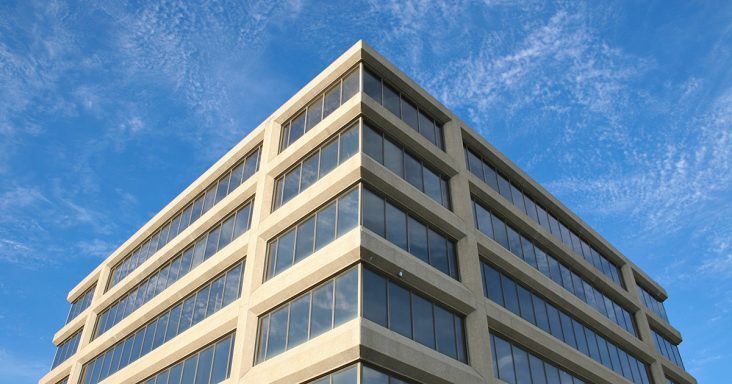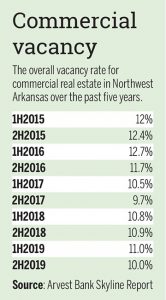Skyline Report: Commercial vacancy rate in NWA fell to 10% in second half of 2019
by March 31, 2020 10:07 am 963 views

The overall vacancy rate for commercial real estate in Northwest Arkansas declined 1 percentage point to 10% in the second half of 2019, from the first half of 2019, as experts await the effects on the market from the COVID-19 (coronavirus) pandemic, according to a new real estate report.
Fayetteville-chartered Arvest Bank released Tuesday (March 31) the semiannual Skyline Report on commercial real estate in Northwest Arkansas for the second half of 2019. The bank previously released Skyline Reports on residential and multifamily real estate for the second half of the year. Arvest Bank sponsors the reports that are completed by the Center for Business and Economic Research (CBER) in the Sam M. Walton College of Business at the University of Arkansas.
The overall vacancy rate for commercial real estate fell to the second-lowest level in five years and was up slightly from the 9.7% rate in the second half of 2017. Meanwhile, the value of commercial building permits that were issued in Northwest Arkansas rose to a 15-year high in 2019.
Permit values rose 1.1% to $363.9 million in 2019, from $359.9 million in 2018, reaching the highest one-year total since the start of the Skyline Report in 2004. In the second half of 2019, $197.5 million in commercial building permits were issued, up from $166.4 million in the first half of the year. Permit values were $169.79 million in the second half of 2018.
The vacancy rate for office space in Northwest Arkansas fell narrowly to 8.5%, the second-lowest vacancy rate since the Skyline Report started. The office vacancy rate has been below 9% for the past three half-year reporting periods, including 8.4% in the second half of 2018, 8.6% in the first half of 2019 and 8.5% in the existing report. Over the past 18 months, 424,542 square feet of new office space has been added to the rental market.
“The Northwest Arkansas market has added more than 1.5 million square feet of new office space since the beginning of 2015, and during this time the vacancy rate for such space has steadily fallen,” said CBER Director Mervin Jebaraj. “This demonstrates the continued demand for quality, rentable office space in the region. It will be very interesting to see how the current financial situation due to COVID-19 impacts growth and demand in the region in the near-term.”

The vacancy rate for retail space fell to 9.4% in the second half of 2019, from 10.8% in the first half of the year. In the second half of 2019, the retail market had an overall positive absorption of 48,169 square feet, as 19,960 new square feet were added to the market and contributed to net absorption of 28,209 square feet.
The vacancy rate in the warehouse submarket declined to 9.4% in the second half of 2019, from 10.3% in the first half of the year. The warehouse submarket had an overall positive absorption of 292,732 square feet, as 355,405 square feet were added in the second half of 2019, leading to negative net absorption of 62,673 square feet.
“The commercial real estate market in the region continues to see strong growth and even stronger demand,” said Mark Ryan, executive vice president and loan manager for Arvest Bank of Benton County. “Almost as quickly as developers can complete new projects, they are becoming occupied. At Arvest, we will be closely monitoring how the current economic situation will impact the market and working with our customers to ensure that they are making the necessary adjustments to their future plans.”
